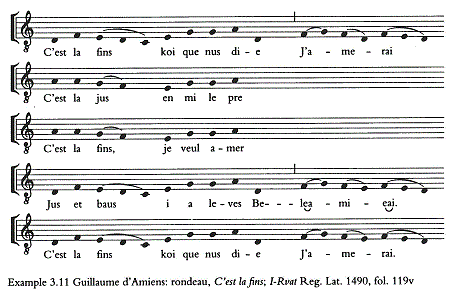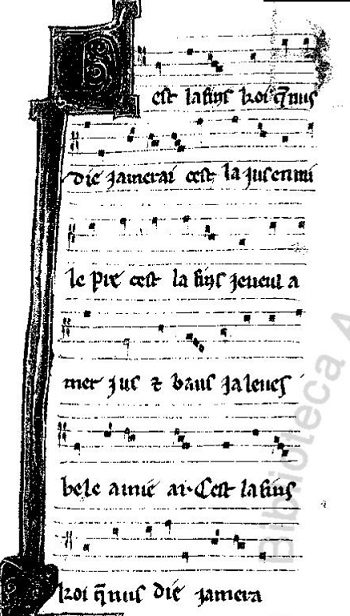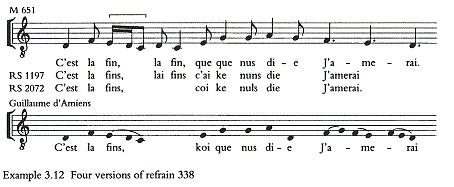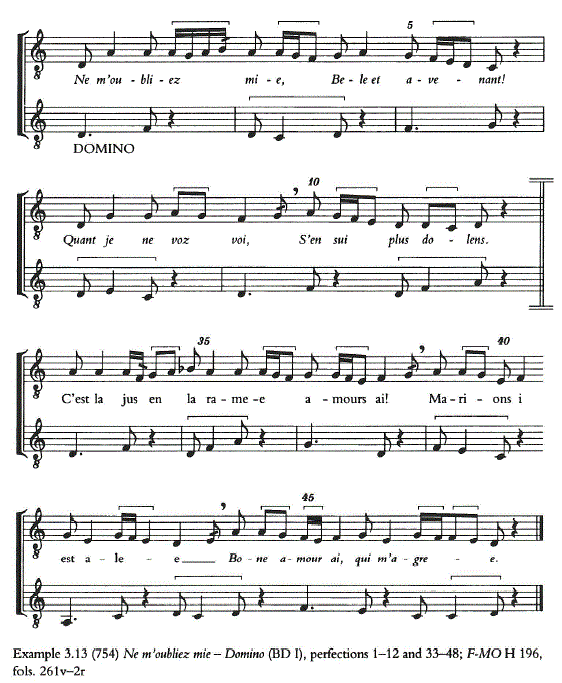| French Motet in the Thirteenth
Century6 |
| The french motet Refrain and clausula(p66) �@l�� the fourth volume of her monumental study of the Montpellier Codex, Yvonne�@Rokseth drew attention to some of the problems associated with refrains discussed�@in this chapter.23 She was intrigued by a group of motets that seemed both to make use of refrains and to be derived from clausulae. Instinctively, one might assume that these two attributes were mutually contradictory. However, �� consideration of some of the implications of these motets will not only enrich our understanding of the ways in which r��frains and motets interact. but will also suggest that refrains may have originated in the motets themselves, and then have been quoted in other genres. The works t�� which Rokseth drew attention were as follows: �@Yvonne�@Rokseth �́A�����y���G�ʖ{�Ɋւ���ޏ��̋L�O��I�Ȍ����̑�S���ɂ����āA���̏͂Ř_����ꂽrefrain�Ɋւ�����̂������ɊS�������Ă����B�ޏ��́Arefrain���g���A���N���E�Y������h�������悤�ɂ������郂�e�b�g�̃O���[�v�ɋ����������Ă����B���Ƃ��Ƃ����2�̑����́A���݂ɖ������Ă���Ɛ�������邩������Ȃ��B�������A�����̃��e�b�g�̈Ӗ����l�@���邱�Ƃ́Arefrain�ƃ��e�b�g�̑��݊W�𗝉���[�߂邾���ł͂Ȃ��Arefrain�̓��e�b�g���g�̋N���ł��邩������Ȃ����A���̕��삩��̈��p�ł��邩������Ȃ��Ƃ������Ƃ����x������ł��낤�BRokseth����������i�͈ȉ��̂悤�ł���B 1�(652) Plus bele que flor �\ (650) Quant revient et fuelle��(651) L'autrier joer �\ Flos flius eius(O16) 2�(396) Se j'ai servi longuement �\ (397) Trop longuemt-Pro patribus(M30) 3. (419) Li pluiseur se plaignent��Virgo (M32) 4�(62) En mait que neist - Dotttine (M3) 5�(754) Nem'oubliez mie �\ Domino (BD I) 6�(250) Quqnt voi la fleur ��Et tenuemnt (Ml7)� We have already agreed to postpone discussion of motets whose refrains occur in that one location only. The third and the sixth pieces fall into this category, and we may therefore omit them from our discussion. The remaining works will be discussed in turn. ��X�͂��łɁArefarain���ꂩ���݂̂ŏo�����郂�e�b�g�ɂ��āA�c�_���������邱�Ƃɓ��ӂ����Ă���B �����ɋ�����No.3��No.�U������ɓ��Ă͂܂�B����䂦�A���҂͂������珜�O���Ă悢�ł��낤�B�c��̍�i�ɂ��āA���ɘ_���Ă݂����B 1�(652) Plus bele que flor- (650) Quant revient et fuele��(651) L'autrier joer �\ Flos flius eius(O16) This is �� work whose earlier Latin history has already been discussed. The refrain �eC'est la fin la fin, que que nus die j'amerai (vdB 338) occurs at the end of the motetus. The refrain is also found ��t the end of the third stanza of �� chanson avec des refrains (RS 1197.�V)�C��t the end of the first stanza of another chanson avec des ref��ains (RS 2072.1), and also in a rondeau by Guillaume d'Amiens, C'est la fin koi que que nus die.24�@ The motet and the rondeau are preserved with music. The music of the rondeau by Guillaume d'Amiens, C'est la fins, is therefore of some s�����������������������C and ���� edition of the piece is given as Example 3.11. ����͂�葁���̃��e����̗��j�����łɘ_���Ă�����i�ł���B���e�b�g�ƃ����h�͉��y�ɂ��łɑg�ݍ��܂�Ă���B refrain �eC'est la fin la fin, que que nus die j'amerai (vdB 338) �́Amotetus�̍Ō㕔���Ō����B����refrain�͂܂��A�ʂ�chanson avec des ref��ains (RS 2072.1)�̑�R�X�^���U�̍Ō㕔���ɂ�����A����ɁAGuillaume d'Amiens�ɂ��rondeau C'est la fin koi que que nus die�ɂ������24�B���e�b�g��roudeau�́A���y���Ă���B Guillaume d'Amien�ɂ�� rondeau�@C'est la fins�̉��y�́A����䂦�ɁA�������d��ȓ_������������A���̍�i��ҏW�������̂�Example 3.11�Ɏ�����Ă���B  �G���ۂ̎ʖ{�ł�fol.123r�ɓ����Ă��� http://digi.vatlib.it/view/MSS_Reg.lat.1490?ling=en  This rondeau differs ��r���� most other thirteenth-century specimens in three ����s������ts�B First, the music of lines 3 and 4 does not match the first line of the refrain. Although the last four pitches are the same, the first two notes and the first ligature are completely different. Second, the text of line 4 might be expected to duplicate that of the first line of the refrain. Certainly, the first three words are the same, but they continue differently. Coupled with the musical differences just outlined, this can hardly be said to constitute �� standard internal refrain line. Finally, although lines 5 and 6 mirror the music of the refrain, as is usual, the musical phrases and lines of poetry are made to overlap. In the new text added t�� the music of the refrain, we might also expect the line-lengths of the poem to be maintained. But, ��s can be seen from Example 3. 1 1 , line 5 loses its feminine rhyme, and line 6 appropriates the single pitch d for its first syllable.25 ����rondeau�́A�R�̓_�ɂ����āA���̑啔���̂P�R���I�̗�Ƃ͈قȂ��Ă���B�܂��ŏ��ɁA�R�s�A�S�s�̉��y��refrai�̑�P�s�ƈ�v���Ă��Ȃ��B�Ō�̂S�̃s�b�`�͈�v���Ă��邪�A�ŏ��̂Q���ƍŏ��̘A�����i�G����Ɋւ��ẮA���ۂ̎ʖ{�����Ă������������j�͊��S�ɈقȂ��Ă���B�Q�ԖڂɁA��S�s�̉̎���refrain�̍ŏ��̍s�Əd�����邱�Ƃ����҂���邪�A�m���ɍŏ��̂R��͂����Ȃ��Ă͂��邪�A�������t��(refrain�̌�Ƃ́j�قȂ��Ă���B�O�ϓI����Ƒ����ւ��āA����ł͂ƂĂ��A�W���I�ȓ�����refrain�s�Ƃ͌����܂��B��R�ɁA��T�s�A��U�s�͒ʏ�ʂ�Arefrai�̋����ɂȂ��Ă��邪�A���y�I�t���[�Y�⎍�s�͏d�����Ă���Brefrai���̉��y�ɐV���ɉ̎����t��������ꂽ�ꍇ�A���̍s���͈ێ�����邱�Ƃ����҂����̂����AExample 3. 1 1 �ɂ����ẮA��T�s�͂���feminne ryme�������A��U�s�͍ŏ��̃V���u���ɂ���悤�ɁA�������K���ł���i�G�ʖ{�ł́A�ŏ��̃V���u���ł������ł͂Ȃ��A�~���ɂȂ��Ă��邪�j�B �@More striking is the fact that the refrain in the rondeau has two words fewer than that of the motet: �e C'est la fin koi que que nus die'inst������ �����eC'est la fin, la fin, que que nus die'. This points up one of the two important characteristics in the transmission of this refrain. All fo��r versions, two with music and two without, are given as Example 3.12. The motetus under consideration shares the repetition of the words �ela fin' with the chanson Amours me sermont (RS 1197). The rondeau omits this repetition, as does the other chanson Bele ��'est la revenue (RS 2072). However, this pairing is contradi��ted by the fact that both the refrain in the motet and in Bele m'est la revenue�C(RS 2072) are prefaced by exactly the same line of poetry: �eK�fen fre��ai?'. This might s��ggest some similarity of origin for these two versions of the refrain. �@����ۓI�Ȃ��Ƃ́Arondeau�ɂ�����refrain�����e�b�g�e �̂�����Q�ꏭ�������Ƃł���B���Ȃ킿�AC'est la fin, la fin, que que nus die�̑����C'est la fin koi que que nus die'�ƂȂ��Ă���B�����������Ƃ��A����refrain��transmission�ɂ�����Q�̏d�v�ȓ����ł���B�S�̂��ׂĂ̔ł�Example 3.12�Ŏ��グ���Ă���B�V�����\��Amours me sermont (RS 1197)�ɂ����ẮA�ela fin' �͌J��Ԃ����B����rondeau�ł͏ȗ�����Ă���B�ʂ̃V�����\��Bele ��'est la revenue (RS 2072)�ɂ����Ă����l�ł���B�������Ȃ���A���������g�ݍ��킹�́A���e�b�g��Bele m'est la revenue�C(RS 2072)�ɂ�����refrain�����m�ɓ������s�eK�fen fre��ai?'�ɂ���đO�u������Ă���Ƃ��낪��������B����́A�����ӂ���refrain�̔ł̃I���W�i��������ł��邱�Ƃ��������Ă���̂ł��낤�B  2�(396) Se j'ai servi longuement �\ (397)Trop longuemen��Pro patribus (M30) Van den Boogaard identifies two refrains in the motetus of this composition. The first, 'Je l'avrai / L'amor a la bele / Girondele / S'aimor, je Vavrai (vdB 1054), is only fo��nd in this one motet, and thus requires treatment with care. The second,�eDame,iert il toz jors ainsi/Que J'amerai sans guerredon' (vdB 411), occurs at the end of the motetus. It is also found in an anonymous rondeau appended to �� salut d'amours in the manuscript Paris, Bibliotheque Nationale, fonds fran��ais 837, unfortunately without music. The t����ts of the versions in Montpellier and the salut d'amours match very closely apart from small orthographical variants, but the range of textual variants in the concordances for the motet suggest little. Van den Boogaard�́A���̍�i��motetus���ɁA�ӂ���refrain�肵�Ă���B�ŏ���Je l'avrai / L'amor a la bele / Girondele / S'aimor, je Vavrai (vdB 1054)�́A���̃��e�b�g�݂̂Ɍ������Ă���A����䂦�ɁA���̈����ɂ͒��ӂ�v����B�����ЂƂ́eDame,iert il toz jors ainsi/Que J'amerai sans guerredon'�ŁAmotetus�̍Ō�Ɍ����B����͂܂��A��ҕs����rondeau�iParis, Bibliotheque Nationale, fonds fran��ais 837�ʖ{����salut d'amours �ɕt������j�ɂ����Ă��������Ă���B�����y���G�ʖ{���̔ł̉̎���salut d'amours�̓����y���G�ƃ����y���G�̃o�[�W�����̕\�L�́A�����Ȑ����@��̈Ⴂ�͂Ƃ������A���ɂ悭���Ă���B�������A�̎��̕ω��̊����̓��e�b�g�ɑ����v���͔��ɏ������B 3. Excluded for reasons given above 4�(62) En mai, que neist �\ Domine (M3) En mai, que neist is �� two-part motet from the sixth fascicle of Montpellier whose motetus ends with the refrain: �eCele m'a s'amor dourne, / Qui mon cuer et mon cors a�f (vdB 314). This is ��refrain that has ����cited interest for various reasons since 1924 when Ludwig tabulated most of its occurrences in his contribution to �`��������'s Handbuch der Musikgeschichte.26 There are six presentations of the music of this ref��ain: the original clausula, �� chanson (RS 2041), the motet under discussion, where it occurs at the end ���� t���� motetus, two other motet voices and �� rondeau motet. The music to all these presentations is in essence the same, although differing transposition levels separate the chanson and one of the motets ����om the rest of the complex. Ludwig's opinion was that the clausula served as the model for a11 these presentations. The piece will discussed in the context of the rondeau-motet in Chapter 5. En mai, que neist�́A�����y���G�ʖ{�̑�U���q�ɂ���Q�����e�b�g�ł��邪�A����motetus��refrain �eCele m'a s'amor dourne, / Qui mon cuer et mon cors a�f (vdB 314)�ŏI����Ă���B�����Ludwig�����̃��e�b�g�ɂ���������P�X�Q�S�N�ȗ��A���܂��܂ȗ��R���狻���[��refrain�ł���B����refrain���g�������y�͂U��ނ���B�I���W�i���̃N���E�Y���A�V�����\��(RS 2041)�A�����ň����Ă��郂�e�b�g�A����ɂQ�̃��e�b�g�Arondeau���e�b�g�̂U�ł���B�قȂ���transposition�̃��x�����V�����\���ƕ����̂̎c�肩��̃��e�b�g���͂��Ă��邪�A����炷�ׂẲ��y�͖{���I�ɓ���ł���BLudwig�̈ӌ��ł́A�N���E�Y���͂���炷�ׂĂ̍�i�̃��f���ƂȂ����A�Ƃ������Ƃł���B���̒��ŁArondeau���e�b�g�Ɋւ��ẮA��T�͂ɂĎ�舵���B 5�(754) Ne m'oubliez mie �\ Domino (BD I) Like En mai, quant neist, Ne m 'oubliez mie is �� two-part motet found in the sixth fiscicle of the Montpellier Code��. However, it includes two refrains that each occur elsewhere.�@Interestingly, the circulation of both is entirely restricted to the motet repertory. Example 3.13 is an edition of those parts of the piece in which r��f������s are fo��nd. One refrain, �eNe �� 'oubliez mie/ Bele et avenant/ Quant je ne voz voi / S'en sui plus dolens' (vdB 1361), opens the motet and another, �eBone amor ai qui m'agre' (vdB287), closes It. The first r��frain is found at the end of the motetus of another two-part motet from the sixth fascicle of Montpellier, (567) La plus bele�\ Pacem (M72)� En mai, quant neist���l�A Ne m 'oubliez mie�́A�����y���G�ʖ{�̑�U���q�ɂ���Q�����e�b�g�ł���B�������Ȃ���A����́A���ꂼ�ꂪ���̏ꏊ�ɂ����݂���ӂ���refrain���܂�ł���B�����[�����ƂɁA��refrain�̂��������z�́A���e�b�g����Ɍ����Ă���BExample 3.13�́Arefrain�����݂����i�̂������������̕ҏW�������B�Е���refrain �eNe �� 'oubliez mie/ Bele et avenant/ Quant je ne voz voi / S'en sui plus dolens' �́A���e�b�g�ɊJ����Ă��邪�A�����Е���refrain�@�eBone amor ai qui m'agre' �͕�����Ă���B�ŏ���refrain�́A�����y���G�ʖ{���̑�U���q�̕ʂ̂Q�����e�b�g����motetus�̍Ō㕔���ɂ�����B  The only differences concern tiny variations in spelling and one small change in ornamentation, and need not concern us here. The second refrain is only slightly more widely distributed: it is found�C ��s in Ne m'oubliez mie�C at the end of the motetus, in two other ����t��ts: (342) Quant vox yver �\ (343) An douz tans pleisant��Hodie perlustravit (M25) and (393) Mainte dame �\ Han(M29). The fi��st of these two is found in the fifth fascicle of the Montpellier Codex (because it is in three ������ts)�@������ in the Munich fragments. The second survives ���� �q���� and Noailles, two chansonniers with large motet collections. Again the differences between the version of the refrain in Ne m'oubliez mie and the other two motets are minimal� �i��refrain�́j�B��̑���́A�X�y���̏����ȕω��A�����̏����ȕω��Ɋւ�����̂ł���A�����ł͂قƂ�NJS����K�v���Ȃ��B��ڂ�refrain���ق�̏��������A���L�����z���Ă���B Ne m'oubliez mie�Ɋւ��ẮA���̂ӂ��̃��e�b�gQuant vox yver �\ (343) An douz tans pleisant��Hodie perlustravit (M25) and (393) Mainte dame �\ Han(M29)�̍Ō�ł݂���B���҂̂����̍ŏ��̕��́A�����y���G�ʖ{�̑�T���q�ƃ~�����w���t���O�����g�ɂ����Ă�������B���Ƃ̕��́A�q�����ʖ{����� Noaille�ʖ{���ۑ�����Ă���B���ʖ{�͑�K�͂ȃ��e�b�g�R���N�V���������V�����\���W�ł���B�J��Ԃ����A���e�b�gNe m'oubliez mie�Ƒ��̂ӂ��̃��e�b�g�̊Ԃ̍��ق́A�ŏ����ł���B �@Rokseth limited her enquiry to the motets found in Montpelli��r; but there are two further pieces that make use of refrains and that include �� ��������s��la in their compositional history. They are (402) L'autrier quant me chevauchoie- Pro patribus (M30), and (515a) Quant I'alouete saut �| Qui conservaret (M50). Both pieces are based on clausulae in the Florence manuscript, and in each, �� t����tual and musical fragment finds its way into another motet: respectively (406) Se Ionguement �\ Benedicta (M32), and (83) L'autrier m'esbatoie �| (84) Demenant grant joie�| Manere (M5). The pieces add little in the way of evidence to our discussion of the question of refrain and clausula� �@Rokseth�̓����y���G�ʖ{���̃��e�b�g�ɑ��錤���ɍi�������Arefrain���g�p���A�N���E�Y�����܂�����Ȃ�Q�̃��e�b�g������B(402) L'autrier quant me chevauchoie- Pro patribus (M30), and (515a) Quant I'alouete saut �| Qui conservaret (M50)�ł���B����i�́AF�ʖ{���̃N���E�Y�����x�[�X�Ƃ��Ă���B�����Ă��̂��̂ɂ����āA�̎��Ɖ��y�̒f�Ђ����̃��e�b�g���ɑ��݂��Ă���B���ꂼ��� (402) L'autrier quant me chevauchoie- Pro patribus (M30), and (515a) Quant I'alouete saut �| Qui conservaret (M50)�ł���B����i�́Arefrain�ƃN���E�Y���̋^��_�ɂ�����_���ɂ͂قƂ�lj����Ȃ��B �@Two explanations have been offered for the presence of a refrain in �� motet based on a clausula.27 Either a composer took the text only of �� refrain and applied it to the music of a phrase ���� �� clausula, or the refrain originated in the process of adding a French t����t to �� clausula (and thereby creating �� ����t��t)�@������ was subsequently cited or quoted in �� variety of other genres. The first of these alternatives is difficult to sustain on the basis of the surviving evidence. One would want to see evidence of �� refrain whose melody had been abandoned and whose poetry had been reused to text �� clausula as part of the process of creating �� motet. Such evidence is not forthcoming, and this hypothesis remains only �� theoretical possibility. Rokseth's second alternative is the more attractiv���C as the preceding discussion has suggested� �@�N���E�Y�����x�[�X�Ƃ������e�b�g�ɂ�����refrain�̑��ݗ��R�ɂ͂ӂ��̐�������B��Ȏ҂�refrain�̉̎��݂̂����o���A������N���E�Y���̃t���[�Y�̉��y�ɓK�p�������A�܂��́i���ꎩ�g�����e�b�g�����グ���j�N���E�Y���ɑ��ăt�����X��̉̎���t��������ߒ��ɂ�����refrain���ŏ��Ɏn�܂������A�ł���B���̌��ʁArefrain�͎���ɁA���l�ȑ��̕���Ɉ��p�����悤�ɂȂ��Ă������B����������ґI���̂����̍ŏ��̕��́A��������؋������܂�Ȃ��B�N�����A���̐������̂ċ����A���̎����i���e�b�g�`���ߒ��̈ꕔ�Ƃ��Ắj�N���E�Y���̉̎��ɍė��p���ꂽrefrain�̏��������Ǝv�����낤�B���������͂������A�������Ă���Ƃ͎v���Ȃ����A���̉����͗��_�I�\���ɂƂǂ܂邱�Ƃ��낤�BRokseth����ґI���̂�����������̕��́A��薣�͓I�ł���B �@These refrains originate in polyphony ������ circulate subsequently in monophonic and perhaps non-musical contexts. This is really not surprising, since we can see many examples of �� similar procedure whereby entire motet voices, originally derived from clausulae, are divorced from their polyphonic context. The resulting monodies are then copied into manuscripts of trouvere song in �� notation that makes them almost unrecognisable.28 This is analogous to the creation of refrains out of motets derived fr���� clausulae. Two examples may be instructive here� �@��������refrain�́A�|���t�H�j�[�Ŏn�܂�A���̌エ���炭�̓��m�t�H�j�[�≹�y�����Ă��Ȃ��e�L�X�g�ɂ����ĉ���Ă����B����͋����ׂ����Ƃł͂Ȃ��B�Ȃ��Ȃ��X�́A���Ƃ��Ƃ̓N���E�Y������R���������̂ł������e�b�g�̐����S�̂��|���t�H�j�[���番���ꂽ���l�̉ߒ��̗���������邱�Ƃ��ł��邩��ł���B���̌��ʂƂ��Ă̒P����i�̓g�����F�[���̎ʖ{�ɂ����Ďʕ�����Ă����i���̋L���͑啔���A����s�\�ł͂��邪�j�B����́A�N���E�Y���R���̃��e�b�g�Ƃ͕ʂ�refrain�̑n���ߒ��Ǝ��Ă���B�����ł͂Q�̗���o���Ă݂悤�B �@The motet (415) Pour conforter�\ Go(M32) is based on �� clausula. But the motetus of this motet also functions as the complete first stanza of a chanson avec des refrains (RS 19.1). The last two lines of the motetus: 'Je voi venir Emmelot / Par mi le vert bois' therefore become the refrain ��t the end ���� the first stanza. The remaining two stanzas, as is always the case in �� chanson avec des r��frains, make use of different refrains. Similar is the motet (764) Hyer matin a Venjornee �\ Domino(�a�c VI) in which the motetus of the clausula-derived motet becomes the entire first stanza of a chanson �� refrain embedded in the Miracles o�� Gautier de Coinci.29 Here the last eight lines of the motetus become not only the refrain at the end of the first stanza but end all the stanzas of the song. �@���e�b�g(415) Pour conforter�\ Go(M32)�́A�N���E�Y�����x�[�X�ɂ��Ă���B�������A���̃��e�b�g��motetus�͂܂��Achanson avec des refrains (RS 19.1)�̑�P�X�^���U�S���Ƃ��ċ@�\���Ă���Bmotetus�̍Ō�̂Q�s�� 'Je voi venir Emmelot / Par mi le vert bois' �ł��邪�A����䂦�ɁA��P�X�^���U�̍Ō�ɂ����āArefrain�ƂȂ��Ă���B���l�Ȃ��Ƃ��A���e�b�gHyer matin a Venjornee �\ Domino(�a�c VI)�ɂ����Ă�������B�N���E�Y���R���̃��e�b�g�̂���motetus�́A Miracles o�� Gautier de Coinci�ɖ��ߍ��܂ꂽchanson �� refrain�̍ŏ��̃X�^���U�S�̂ƂȂ��Ă���B����motetus�̍Ō�̂W�s�́A�ŏ��̃X�^���U�̍Ō��refrain�����łȂ��A�̂̃X�^���U���ׂĂ̍Ō�ƂȂ��Ă���B �@To return to Rokseth's group of clausula-derived motets with refrains, four pieces are of interest. One, (396) Se j'ai servi longuement �\ (397)Trop longuement��Pro patribus(M30), is equivocal. The only other occurrence of the refrain either survives without music or was never intended to include it. The three ��ther pieces demonstrate �� series of musical and lyric relationships that support the idea that the music of the r��frain originated in the clausula. The lyric of the refrain arose ����t of the process of writing a vernacular text to the clausula. The refrain subsequently circulated in the same way as refrains that originated in chansons ��r ����������������. The origins of the r��frain �e�b'est �ela fin, la fin' (vdB 338) may be even more complex. It may also affect our view of the origins of the entire family of �eFlos filius' motets. It is possible that the presence of the refrain in (652) P��us bele que flor�\ (650) Quant revient et fuelle - (651) L'autrier joer �\ Flos filius eius (016) may be the result of texting �� clausula with �� Latin text and only subsequently creating a French contrafactum. The music of the refrain would then have undergone two textings before reaching the form in which It circulated as �� refrain. �@Rokseth�N���E�Y���R����refrain�����e�b�g�Q�ɖ߂�ƁA�S�̍�i�ɊS���s���B�ЂƂ�Se j'ai servi longuement �\ (397)Trop longuement��Pro patribus(M30)�ł��邪�A�s�m���ł���Brefrain�̗B��̑��̃\�[�X�ɂ�����o���͉��y�Ȃ��Ă��炸�A���������X�����Ȃ����̂R��i�́A���̉��y���N���E�Y���ɂ����Ĕ��������Ƃ���l�����x������悤�����y�ƝR��̊W�������Ă���Brefrain�̝R��̓N���E�Y���ɑ��Ă���ꂽ�����̎��������ߒ�������ɂ���Brefrain�͑������܂ɁA�V�����\����rondeaou�Ŕ�������refrain�Ƃ��Ăӂ�܂��Brefrain�e�b'est �ela fin, la fin' (vdB 338)�̋N���́A�����炭�͕��G�̂ł��낤�B������eFlos filius'�̃��e�b�g���S�̂̋N���ւ̌����ɂ��e����^���邱�Ƃ��낤�B���e�b�g (652) P��us bele que flor�\ (650) Quant revient et fuelle - (651) L'autrier joer �\ Flos filius eius (016) �ɂ�����refrain�̑��݂��A���e����̎������N���E�Y�����t�����X��ɉ̎��Â�������A�t�����X���contrafacta�����グ�����ʂƂȂ����\���͂���Brefrain�̉��y�́A���ꂪrefrain�Ƃ��ĉ���Ă����`���ɂ��ǂ���ȑO�ɁA�ӂ��̉̎��i���e����ƃt�����X��j������Ă����̂��낤�B �@The foregoing comments would be concrete evidence that could be set against the traditional view of motets quoting or borrowing refrains were it not for one complicating factor: the clausulae that form part of the compositional history of the pieces that we have just been investigating were not embedded in organa in their original sources. They may be clausulae that were conceived ����t to enrich the musical fabric of organa but as notational models for motets. �` compositional scenario in which a �e����r������' borrowing of a refrain takes place in �� newly composed motet and in which a clausula is created to act as �� notational prop is entirely believable. Whatever interpretation one might want to place on these pieces does not contradict the �eborrowing' or �equotation* hypothesis but demonstrates again how these compositions need to be assessed individually. �@�O�q�������Ƃ���́Arefrain�����p������ؗp�������e�b�g�ւ̓`���I�Ȍ����ɔ�����悤���؋�����̉��������Ƃ��낤�B���������ꂪ���G�ȗv�f�������Ă��Ȃ���B��X������܂Ō������Ă�����i�̌`���j�̈ꗃ��S���Ă���N���E�Y���́A�I���W�i���ȃ\�[�X�ł���I���K�k���ɖ��ߍ��܂�Ă��Ȃ��B�������I���K�k�������y�L���ɂ��邽�߂ɂł͂Ȃ��A���e�b�g�̂��߂̋L�����f���Ƃ��Đ��܂ꂽ�̂ł���B�@refrain�̒ʏ�́u�ؗp�v���V�������ꂽ���e�b�g�ɂ����ċN��������A�N���E�Y�����L���̏����Ƃ��č��ꂽ�Ƃ�����ȃV�i���I�́A�S�̓I�ɂ͐M���ł���B�����̍�i�ɂǂ̂悤�ȉ��߂����Ă��悢���ǂ����́A�u�ؗp�v�܂��́u���p�v�����ɒ�G������̂ł͂Ȃ��A�����̍�i���ʂɕ]������K�v�����邩�ǂ������ēx�����̂ł���B |